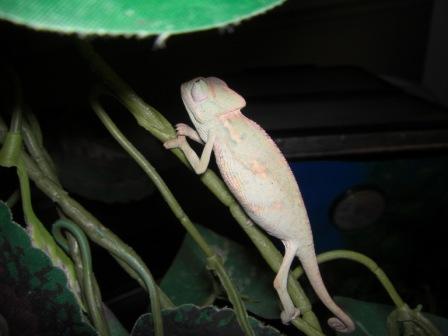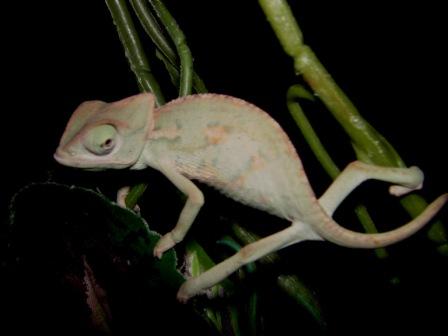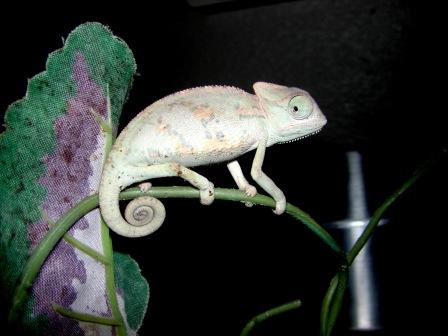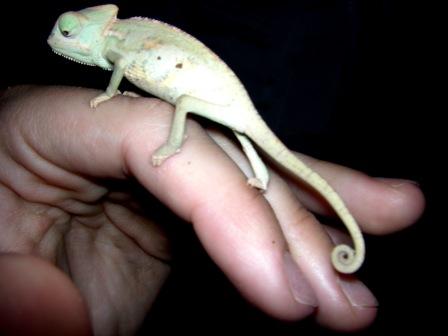karebear41486
Established Member
I have been doing tons and tons of research over the past month about veiled chameleons and setups and lighting etc...
I am planning on purchasing a male baby veiled (probably only a few months old) from the PetSmart where I work. He is definitely not getting the complete care he needs there, and I am determined to give him the perfect home. I am going to describe my plan of action thus far and ANY thoughts or suggestions are greatly appreciated!!! (Especially about supplementation, because I've read so many different things about calcium with d3, pure calcium, multi vits., etc...and its so confusing!)
Enclosure: I am planning on either building my own or purchasing one of the apogee reptariums...and if i get one of the reptariums i was planning on the 175 gallon size.
Lighting: SO stressed about this one...i swear i read something different everywhere i look. After hours and hours of reading i was planning on using a combination of fluorescent bulbs (2) and a basking/uvb bulb. One site i was reading SWEARS on the powersun type basking bulbs that produce basking heat as well as uva/uvb. I also read that these might be too strong or intense for chameleons...especially such young ones? For the fluorescent bulbs i was planning on using a combination of the Reptiglo 2.0 full spectrum along with either the reptiglo 5.0, 8.0. or 10.0....whichever one you all suggest. THEN i read that reptisun are better, and i know they have the 5.0, 8.0, 10.0 types, but do they also recommend using them in combination with a 2.0 type full spectrum bulb (if such a thing exists by reptisun?) I guess what im REALLY wondering is about those powersun type bulbs...because they sound really cool.
Misting/Hydration: Do any of you use waterfalls in your enclosures? I tested one out at work tonight and was surprised at how effectively they worked. Seemed like a pretty good idea, do any of you have experience with them? I was also debating between a drip system or an automatic misting system such as ZooMed's Habba Mist that i saw in a magazine. I have also read on websites that you can put your chameleon on a tall plant and place them in the shower with the water pointed at the wall and bouncing off and hitting the plant and the chameleon, and wondered if you all thought that was a good idea. Seemed kinda harsh to me....but i guess some chams love it? If i did choose to ever do that i think i would wait till my cham was full grown...
Anyways....as you all can see i have many many many questions that i just don't think i will be able to answer for myself by reading website upon website. I need some expert opinions and advice...absolutely anything is appreciated. I feel that i have acquired a load of good information about keeping chameleons, but i just need some reassurance on the really important stuff. Thanks in advance for anything that anyone can contribute!
I am planning on purchasing a male baby veiled (probably only a few months old) from the PetSmart where I work. He is definitely not getting the complete care he needs there, and I am determined to give him the perfect home. I am going to describe my plan of action thus far and ANY thoughts or suggestions are greatly appreciated!!! (Especially about supplementation, because I've read so many different things about calcium with d3, pure calcium, multi vits., etc...and its so confusing!)
Enclosure: I am planning on either building my own or purchasing one of the apogee reptariums...and if i get one of the reptariums i was planning on the 175 gallon size.
Lighting: SO stressed about this one...i swear i read something different everywhere i look. After hours and hours of reading i was planning on using a combination of fluorescent bulbs (2) and a basking/uvb bulb. One site i was reading SWEARS on the powersun type basking bulbs that produce basking heat as well as uva/uvb. I also read that these might be too strong or intense for chameleons...especially such young ones? For the fluorescent bulbs i was planning on using a combination of the Reptiglo 2.0 full spectrum along with either the reptiglo 5.0, 8.0. or 10.0....whichever one you all suggest. THEN i read that reptisun are better, and i know they have the 5.0, 8.0, 10.0 types, but do they also recommend using them in combination with a 2.0 type full spectrum bulb (if such a thing exists by reptisun?) I guess what im REALLY wondering is about those powersun type bulbs...because they sound really cool.
Misting/Hydration: Do any of you use waterfalls in your enclosures? I tested one out at work tonight and was surprised at how effectively they worked. Seemed like a pretty good idea, do any of you have experience with them? I was also debating between a drip system or an automatic misting system such as ZooMed's Habba Mist that i saw in a magazine. I have also read on websites that you can put your chameleon on a tall plant and place them in the shower with the water pointed at the wall and bouncing off and hitting the plant and the chameleon, and wondered if you all thought that was a good idea. Seemed kinda harsh to me....but i guess some chams love it? If i did choose to ever do that i think i would wait till my cham was full grown...
Anyways....as you all can see i have many many many questions that i just don't think i will be able to answer for myself by reading website upon website. I need some expert opinions and advice...absolutely anything is appreciated. I feel that i have acquired a load of good information about keeping chameleons, but i just need some reassurance on the really important stuff. Thanks in advance for anything that anyone can contribute!





